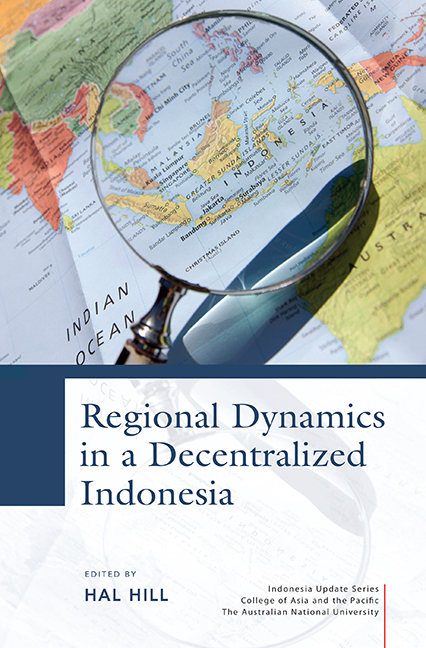Book contents
- Frontmatter
- Dedication
- Contents
- Tables
- Figures
- Contributors
- Acknowledgments
- Glossary
- Map of Indonesia
- 1 An introduction to the issues
- PART 1 HISTORICAL, ECONOMIC, POLITICAL AND SOCIAL PATTERNS
- 2 Before the ‘big bang’: decentralization debates and practice in Indonesia, 1949–99
- 3 Indonesia's decentralization: the rise of local identities and the survival of the nation-state
- 4 Hares and tortoises: regional development dynamics in Indonesia
- 5 Patterns of regional poverty in the new Indonesia
- PART 2 DECENTRALIZATION AND GOVERNANCE
- PART 3 LOCAL-LEVEL PERSPECTIVES
- PART 4 MIGRATION, CITIES AND CONNECTIVITY
- PART 5 CHALLENGES FOR INDONESIA'S PERIPHERY
- Author index
- Subject index
- INDONESIA UPDATE SERIES
3 - Indonesia's decentralization: the rise of local identities and the survival of the nation-state
from PART 1 - HISTORICAL, ECONOMIC, POLITICAL AND SOCIAL PATTERNS
Published online by Cambridge University Press: 21 October 2015
- Frontmatter
- Dedication
- Contents
- Tables
- Figures
- Contributors
- Acknowledgments
- Glossary
- Map of Indonesia
- 1 An introduction to the issues
- PART 1 HISTORICAL, ECONOMIC, POLITICAL AND SOCIAL PATTERNS
- 2 Before the ‘big bang’: decentralization debates and practice in Indonesia, 1949–99
- 3 Indonesia's decentralization: the rise of local identities and the survival of the nation-state
- 4 Hares and tortoises: regional development dynamics in Indonesia
- 5 Patterns of regional poverty in the new Indonesia
- PART 2 DECENTRALIZATION AND GOVERNANCE
- PART 3 LOCAL-LEVEL PERSPECTIVES
- PART 4 MIGRATION, CITIES AND CONNECTIVITY
- PART 5 CHALLENGES FOR INDONESIA'S PERIPHERY
- Author index
- Subject index
- INDONESIA UPDATE SERIES
Summary
INTRODUCTION
Nation-states launch decentralization programs in highly different historical contexts and for a wide variety of reasons (Eaton, Kaiser and Smoke 2010: 8–9). China and Vietnam, for example, have pursued moderate decentralization policies in order to respond to economic modernization pressures. Brazil, South Africa and Mexico introduced decentralization as part of their post-authoritarian transitions, while Cambodia, Rwanda and Uganda gave more power to the local level to heal post-conflict traumas. Most importantly, many developing countries use decentralization as a tool to improve government effectiveness, responsiveness and accountability (Asante and Ayee 2004: 3). Few states, however, implement decentralization as an urgent measure to prevent the disintegration of the state in the middle of a severe political crisis. Arguably, Indonesia in 1999 was such a state: many observers were concerned that, having emerged from 40 years of centralist authoritarianism, post-Suharto Indonesia could become the next Yugoslavia or Soviet Union. Fuelled by the secession of East Timor in 1999, anxiety spread within Indonesia that other parts of the archipelago could also demand independence. While most serious foreign scholars believed that a territorial break-up was unlikely (Cribb 1999; Emmerson 2000; Aspinall and Berger 2001), they nevertheless devoted much time to discussing such a probability. This, in turn, did little to reassure Indonesian policy makers.
Faced with the threat of territorial disintegration, the Indonesian elite turned to decentralization. First designed in 1999 and implemented since 2001, decentralization transformed Indonesia from one of the most centralist nations in the world into a polity with near-federal structures. As a result, the share of regional spending in total government expenditure increased from 17 per cent in 2000 to 40 per cent in 2009 (World Bank 2002, 2009: 65). This reform was implemented despite a number of well-documented risks inherent in decentralization. First, the empirical record of decentralization around the globe is ‘mixed at best in terms of realizing many of the stated objectives of reform’ (Eaton, Kaiser and Smoke 2010: xi), providing no ‘unambiguous proof of its desirability’ (Smoke 2003: 7). Second, ‘decentralization is likely to accentuate the already precarious imbalance within the state’ because it often favours already rich districts over poorer ones (Asante and Ayee 2004: 2). Third, decentralization frequently leads to wasteful spending on bureaucratic apparatuses (Mawhood 1993).
- Type
- Chapter
- Information
- Regional Dynamics in a Decentralized Indonesia , pp. 45 - 67Publisher: ISEAS–Yusof Ishak InstitutePrint publication year: 2014



